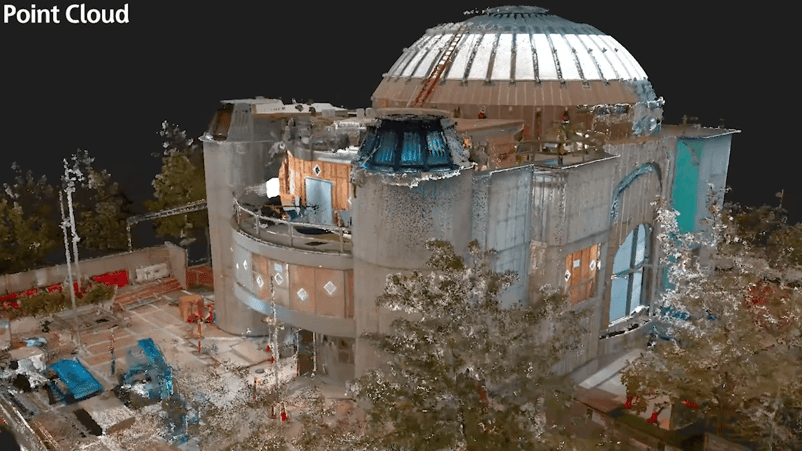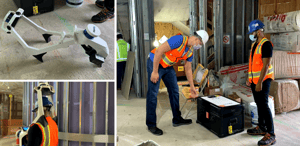"Erfahren Sie, wie die Baufirma Skanska mit Hilfe des NavVis VLX die New Yorker St. Nicholas Church in weniger als 60 Minuten gescannt hat."
"Die ursprüngliche St. Nicholas Church in der 155 Cedar Street in New York City war das einzige Gotteshaus, das bei den Anschlägen vom 11. September 2001 zerstört wurde."
Heute wird ein neues Bauprojekt für die Kirche von Skanska, einem multinationalen Bau- und Entwicklungsunternehmen, durchgeführt, bei dem das NavVis VLX Wearable Mapping System verwendet wird, um die räumliche Koordinierung auf der Baustelle durch die Bereitstellung von genauen Bestandsdokumentation zu unterstützen.
Laut Val Tzvetkov, Senior Regional VDC (Virtual Design and Construction) Manager bei Skanska, konnten die Techniker mit NavVis VLX in weniger als einer Stunde den gesamten Grundriss mit seinen niedrigen Decken und engen Durchgängen erfassen.
"NavVis VLX in weniger als sechzig Minuten den kompakten Grundriss mit komplexen, mehrstöckigen Ecken und Winkeln erfasst."
"Für den Bau des Gebäudes war eine schnelle und genaue Bestandsdokumentation unerlässlich, um die räumliche Koordination zu unterstützen", erklärt Tzvetkov. "NavVis VLX Die Software hat den kompakten Grundriss mit komplexen, mehrstöckigen Ecken und Winkeln (sowohl Bilder als auch Punkte) in weniger als sechzig Minuten erfasst."
Nach ihrer Fertigstellung wird die neue griechisch-orthodoxe St. Nikolaus-Kirche mit Nationalheiligtum in der Liberty Street 130 ein Ort des Gebets und der stillen Besinnung sein.
Das vom spanischen Architekten Santiago Calatrava entworfene Gebäude, das nach dem Vorbild der byzantinischen Kirchen Hagia Sophia und der Kirche des Heiligen Erlösers in Istanbul gestaltet wurde, soll in den Abendstunden als Leuchtfeuer der Hoffnung auf dem Gelände des World Trade Centers erstrahlen.
Datenerfassung mit SLAM ist viel schneller als eine Erfassung mit Stativscannern
Die Dokumentation der Bauarbeiten an der neuen St. Nicholas Church and Shrine wird durch NavVis VLXeinem tragbaren Kartierungssystem, das effizienter ist als herkömmliche Geräte.
"Schnellere und besser zugängliche Daten führen zu rechtzeitigen und effektiven Entscheidungen", sagt Tzvetkov. "Ein gutes mobiles Scannen wird die Erfassung im Feld und die Verarbeitung im Büro erheblich reduzieren."
Er fügt hinzu: "Ein Versuch mit terrestrischer Laserscanner hätte mehrere Tage gedauert."
Tzvetkov ist für die gesamte Bautechnologie in Skanskas jährlichem Bauprojektportfolio in New York mit einem Wert von etwa 800 Mio. bis 1,2 Mrd. US-Dollar verantwortlich. In dieser Funktion implementiert er projektspezifische digitale Strategien, Standards und bahnbrechende Technologien zur Verbesserung des Kerngeschäfts von Skanska.
"Die Technologie vonSLAM ermöglicht eine schnelle Erfassung des Weltraums, die bis zu 90 Prozent schneller ist als das terrestrische Laserscanning."
NavVis VLX ist zweifellos eine bahnbrechende Technologie, die Fachleuten im AEC-Sektor (Architektur, Technik und Bauwesen) die Genauigkeit von vermessungstauglich in einem kompakten, vielseitigen Gerät bietet. Wesentlich für NavVis VLX sind die firmeneigenen SLAM (Simultaneous Localization and Mapping) Algorithmen, die es ermöglichen, die bebaute Umgebung zu kartieren, während man einfach durch sie hindurchgeht.
"Die TechnologieSLAM ermöglicht eine bis zu 90 Prozent schnellere Erfassung des Weltraums als das terrestrische Laserscanning", sagt Tzvetkov.
In den letzten fünf Jahren war Tzvetkov für die gesamte digitale Technologie, BIM und Reality Capture für die 5,1 Mrd. Dollar teure Sanierung des La Guardia Terminal B verantwortlich. Das neue Terminal B wird mehr als 1,3 Millionen Quadratmeter an neuen Einrichtungen umfassen, mit 35 brandneuen Gates, 8 Meilen an neuen Straßen und 18 neuen Straßenbrücken.
Bild- und Videonachweis: Skanska




